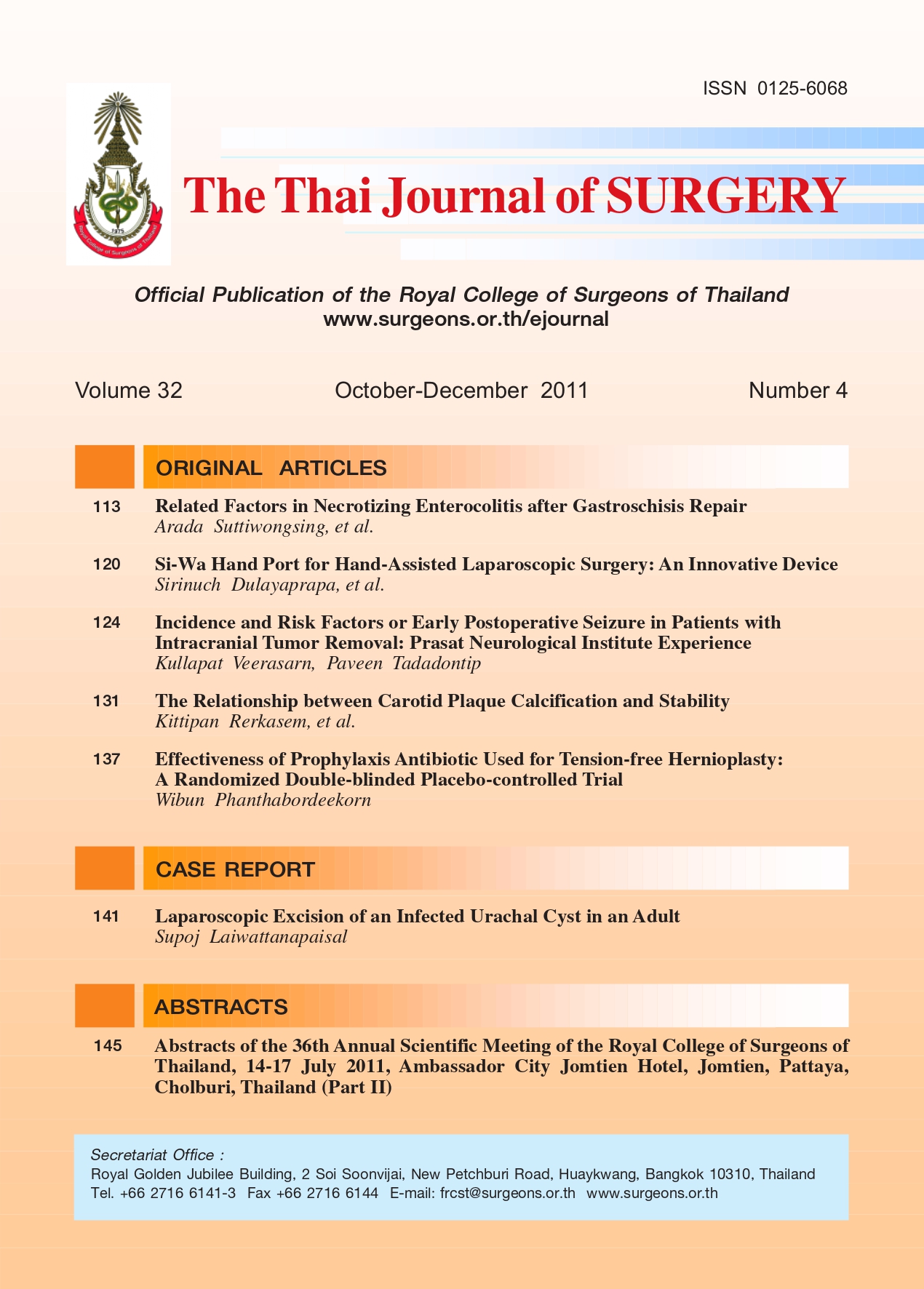Incidence and Risk Factors or Early Postoperative Seizure in Patients with Intracranial Tumor Removal: Prasat Neurological Institute Experience
Keywords:
brain tumor removal, early postoperative seizureAbstract
Objectives: To evaluate the incidence and to identify the risk factors of early postoperative seizure(POSz) (within one week after surgery) in patients underwent intracranial tumor removal.
Methods: Medical records of patients who had their brain tumor removed during June 2006 - May 2007
were reviewed. Data of demography, clinical presentation, operative records and pathology reports were
recorded. The incidence of early POSz was calculated in total number and in subgroup differentiated by
location. Univariate chi square and logistic regression analyses were used to analyze association between
variables and seizure outcome.
Results: The incidence of early POSz for intracranial tumor removal surgery was 9.7 % (21/216) with
13.16 % for convexity lesion, 16.07 % for subcortical location, 2.08 % for posterior fossa location, and 13.89
% for sella and parasellar location. In univariate analysis, male gender, history of pre-operative seizure and
location of tumor were found to relate with early POSz. In multivariate analyses male gender and history of
preoperative seizure were statistically related with early POSz. Role of antiepileptic drug prophylaxis was also
studied and showed a benefit in high risk group with no statistical significance. In patients with early POSz,
seizure occurred mostly on the day 0, day 1 and day 2 after surgery and correctable cause could be identified
in some cases (evacuation of intracranial hematoma in one case, low antiepileptic drug level in two cases).
Conclusions: Early POSz had a high incidence in surgery for tumor located at the locations of convextity,
subcortex and sella parasella. History of preoperative seizure and male gender were the risk factors for early
POSz. Close observation in these groups of patients during the postoperative period and the prescription of
antiepileptic drugs would be necessary.
References
postoperative seizures. Acta Neurochir 1981;55:253-64.
2. Suri A, Mahapatra AK, Bithal P. Seizure following posterior
fossa surgery. Br J Neurosurgery 1998;12:41-4.
3. Lee ST, Lui TN, Chang CN, et al. Early postoperative seizure
after posterior fossa surgery. J Neurosurgery 1990;73:541-4.
4. Temkin NR. Current review. Prophylactic anticonvulsants
after neurosurgery. Epilepsy Currents 2002;4:105-7.
5. Santis AD, Villani R, Sinisi M, et al. Add - on Phenytoin fails to
prevent early seizures after surgery For supratentorial brain
tumor: A randomized controlled study. Epilepsia 2002;43:175-
82.
6. Sirven JI, Wingerchuk DM, Drazkowski JF, et al. Seizure
prophylaxis in patients with brain tumors: a Meta-analysis.
Mayo Clinic Pro 2004;79:1489-9.
7. Warnick RE. Surgical complication and their avoidance. In:
Winn HR, editor. Youmans neurological surgery. 5th ed. USA:
Saunder; 2004. p. 937-8.
8. Boarini DJ, Beck DW, Vangilder JC. Postoperative prophylactic
anticonvulsant therapy in cerebral gliomas.
Neurosurgery 1985;16:290-2
9. Chozick BS, Reinert SE, Samual H, et al. Incidence of seizures
after surgery of supratentorial meningiomas: a modern
analysis. J Neurosurgery 1996;84:382-6.
10. Temkin NR, Dikmen SS, Wilensky AJ, et al. A randomized,
double - blind study of phenytoin, for the prevention of
posttraumatic seizures. N Engl J Med 1990;323:497-502.
11. Beenen LF, Lindeboom J, Kasteleijn- Nolst Trenite’ DG, et al.
Comparative double blind clinical trial of phenytoin and
sodium valproate as anticonvulsant prophylaxis after
craniotomy: efficacy, tolerability, and cognition effects. J
Neurol Neurosurg Psychi 1999;67:474-80.
Downloads
Published
How to Cite
Issue
Section
License
Articles must be contributed solely to The Thai Journal of Surgery and when published become the property of the Royal College of Surgeons of Thailand. The Royal College of Surgeons of Thailand reserves copyright on all published materials and such materials may not be reproduced in any form without the written permission.



